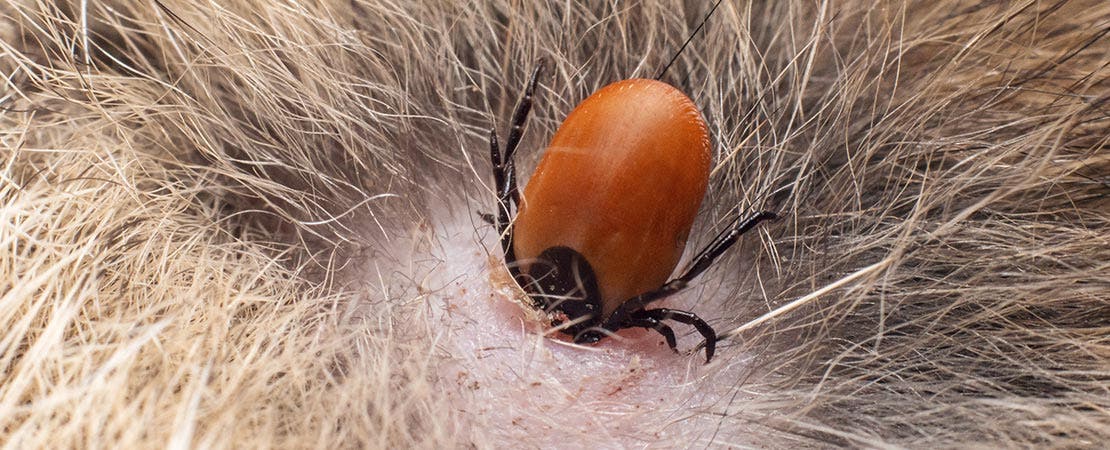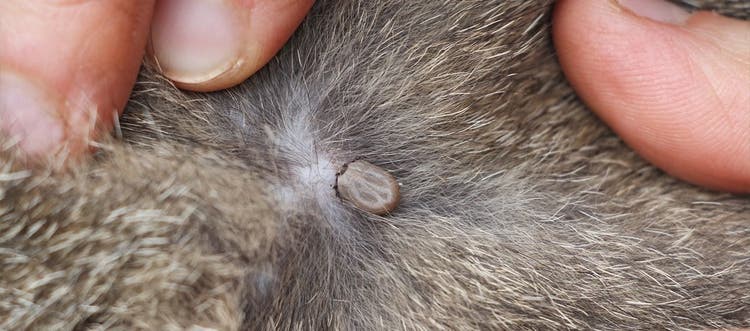What to do if you find a tick on your cat.
Ticks are good at hiding on cats by burrowing into their fur — and these blood-sucking parasites can latch onto cats for days, only dropping off when they’ve finished feeding. Read on to find out how to tell your cat has a tick and what to do about it.
What Does a Tick Look Like on a Cat?
With their eight legs, adult ticks belong to the arachnid family, so they can look similar to spiders. Ticks bite animals and feed on their blood. They’re usually very small when unfed; some are no bigger than the size of a pinhead. A tick’s size will vary as it fills with blood, growing to around half an inch after latching onto a host.
Their color changes too, which can make them more difficult to identify. Unfed ticks are brown with a darker brown area around the mouthparts, and engorged ticks are more circular in shape and gray-colored.

How Do Cats Get Ticks?
Ticks in long grass and vegetation latch onto animal fur or to humans as they brush by. Once a tick has hitched a ride, it’s feeding time. The tick sinks its mouthparts into its new host and begins feeding on their blood. It will stay attached, growing increasingly bigger, until it’s finished feeding after a few days.
How Do I Find Ticks on My Cat?
Although tick bites can be uncomfortable, your cat may not show any obvious changes in behavior. Even when a cat contracts a disease from an infected tick, there may not initially be any visible symptoms. That’s why it’s important to check your cat for ticks regularly, so you can catch it before it turns into anything more serious. Follow these tips to check your cat for ticks:
1. Run Your Fingers Through Your Cat’s Fur
Ticks aren’t quite as hard to spot as fleas — usually by the time you spot a tick, it’s already latched on and feeding, growing bigger each day. Ticks, particularly well-fed ones, feel like small round bumps on the surface of the skin. Stroke your cat gently, feeling for bumps. Sometimes you may find an unfed tick wandering across the surface of your pet’s fur, looking for a place to latch on.
2. Pay Attention to Dark, Hidden Areas
Ticks may often hide in long coats, but they prefer to feed on areas where it’s easier to get close to the skin, such as the neck, head, ears and feet. They also tend to feed in hidden, warm, dark areas of a cat’s body, so pay particular attention to the groin, armpits, between the toes and inside the ears.
3. Know How to Tell Ticks Apart from Skin Lumps
Occasionally, owners mistake a small skin lump on their pet for a tick. A good tip is to look closely for legs; you can identify an adult tick by their eight legs.
4. Take Extra Time for Longer Hair Coats
If you own a long-haired feline, set aside some extra time to check through their coat properly. The small bumps that may indicate a feeding tick can be more difficult to feel through the layers of a thick coat, so ensure you get down right to the skin, using your fingers like the teeth of a comb for a thorough check.

What Should I Do If I Find a Tick on My Cat?
If you find a tick on your cat’s skin, don't panic — and don't pull it. Trying to pry it off can stress your pet out, and the last thing you want to do is squeeze the tick or break it off while it’s feeding, which can increase the risk of infection.
One of the most effective ways to remove a tick is with a tick removal tool, sometimes called a tick hook. These devices are designed to grip the tick at the affected area and remove the tick whole, so there are no parts left in your cat. Be sure to read the instructions on the packaging before starting.
Read our step-by-step guide to removing ticks from cats and find out how to dispose of the tick properly.
Why Are Ticks Dangerous for Cats?
Ticks are unpleasant parasites that may affect your cat — and if your pet becomes a host, the tick may even pose a risk to people in your household. Blood lost in a single tick bite isn’t usually enough to trouble a cat, but in kittens, elderly cats and cats with a lot of ticks, blood loss can be more significant and can lead to anemia.
Ticks can also carry diseases. The bacterial infections Lyme disease and anaplasma can be carried by ticks and passed to cats and even people, if they get a chance to bite.
How Do I Prevent Ticks on My Cat?
Regularly using an effective tick prevention product on your cat can keep ticks at bay, reducing the risk of ticks entering the household. Tick treatments for cats are usually available as topicals, orals or collars. You may also want to continue regular tick checks during spring, summer and fall months when ticks are more prevalent, particularly if your cat likes to wander in high grass and wooded areas.

Seresto® Flea & Tick Collar for Cats
An easy-to-use, odorless, non-greasy collar that kills and repels fleas and ticks for 8 continuous months.

Credelio® CAT (lotilaner)
Protect your feline friend with Credelio Cat, the first and only flea and tick chewable for cats.

Advantage® Treatment Spray for Cats
An on-pet treatment spray that kills and repels fleas, ticks and lice.
Related Articles
Credelio® CAT (lotilaner)
Indications:
Credelio CAT kills adult fleas and is indicated for the treatment and prevention of flea infestations for one month in cats and kittens 8 weeks of age and older and weighing 2 pounds or greater.
Credelio CAT is also indicated for treatment and control of black-legged tick infestations for one month in cats and kittens 6 months of age and older and weighing 2 pounds or greater.
Important Safety Information:
Lotilaner is a member of the isoxazoline class of drugs. This class has been associated with neurologic adverse reactions including tremors, incoordination, and seizures. Neurologic adverse reactions have been reported in cats receiving isoxazoline class drugs, even in cats without a history of neurologic disorders. Use with caution in cats with a history of neurologic disorders. The safety of Credelio CAT has not been established in breeding, pregnant and lactating cats. The effectiveness of Credelio CAT against black-legged ticks in kittens less than 6 months of age has not been evaluated. The most frequently reported adverse reactions are weight loss, rapid breathing and vomiting. For complete safety information, please see Credelio CAT product label or ask your veterinarian.






